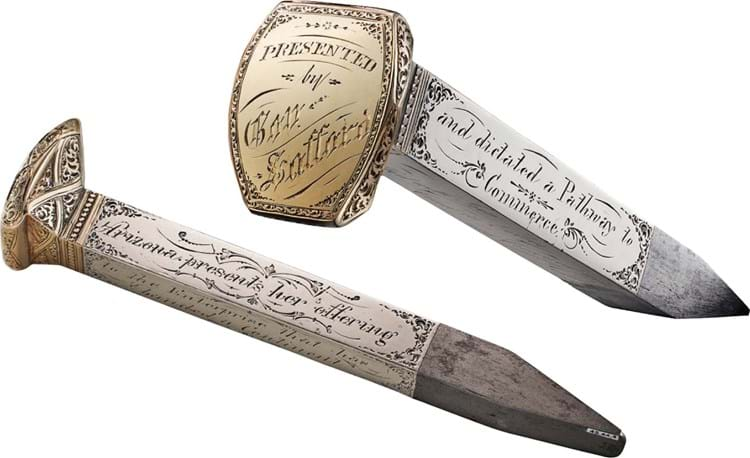
Two views of ‘the Arizona Spike’ used to mark the completion of the Transcontinental railroad in 1869, $1.8m (£1.46m) at Christie’s New York.
Stretching 1911 miles from Sacramento to Omaha, the track provided, for the first time, easy and reliable travel between California and the great industrial centres of the east.
The San Francisco Daily Evening Bulletin declared: “The States of the Pacific will no longer be divorced from the sympathies and affections of ‘the old States.’ The iron road will be a bond of amity as well as of commerce….”
The herculean effort, completed less than four years after Robert E Lee surrendered at Appomattox, had been undertaken by two companies.
Shortly after an Act of Congress was passed in 1863, the Central Pacific began to move eastward across the Sierra Nevadas and into the desert toward the Great Salt Lake. The Union Pacific began work two years later in 1865 and marched westward across the Great Plains from the Missouri river.
As the two tracks inched toward each other, the idea of the ‘Last Spike’ ceremony was born. Come the appointed day, on May 10, 1869, at Promontory Point, Utah, four 6in (15cm) long silver and gold-mounted iron ‘spikes’ would be struck by bigwigs from the Central and Union with the blows transmitted to the nation in real time via the telegraph.
That, at least, was the theory. According to eyewitnesses, the hapless executives missed their spikes, hitting the rails instead, and the sympathetic telegraph operator tapped out the signal by hand.
The four ceremonial spikes (replaced the following day with common iron nails) have since become symbols of the American experience.
While one is considered lost, two are in the Stanford University Museum of Art and until recently another was on view at the Museum of the City of New York.
The latter came up for sale at Christie’s New York as part of the firm’s Exceptional sale on January 27.
Marketed as ‘an evocative symbol of the national optimism that prevailed during the second half of the 19th century’, this particular spike was that commissioned in 1869 by Anson Safford, the newly appointed governor of the Arizona Territory.
The museum was hoping ‘the Arizona Spike’ would raise $300,000-500,000 to benefit its core collection. It did not disappoint, selling for a cool $1.8m (£1.46m) or $2.2m including fees.














